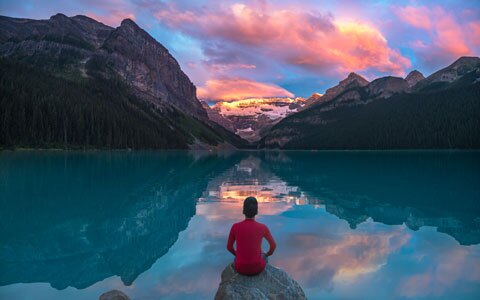Do you have ancestors who settled in Canada? Consider planning a trip to this beautiful country to get a glimpse into their lives through heritage travel. If you have Canadian ancestors, you can get a look at them by checking the My Heritage tab of the Where Am I From activity on FamilySearch.
Canada Travel Requirements
Always check the current travel requirements on the Canadian government website. Also consider looking into the following items:
- Proper identification, including a valid passport
- ArriveCAN, an app that can help you with passports, customs, and declarations at the Canadian international airports
As of July 2023, COVID vaccinations are not required, but always check the COVID travel updates before you go.
Transportation for Canada Travel
In addition to international airports located across the country, Canada also has a national highway, a passenger railroad that crisscrosses the country, ferries in the coastal areas, buses, and various other forms of public transportation.

Tran-Canada Highway
The Trans-Canada Highway is one of the world’s longest highways at 4,860 miles in length. The highway goes through all the provinces and is a great way to see the country. Before you travel, learn a bit about Canadian traffic laws and safety regulations, and make sure to check the local highway conditions before you go.
Canadian Railroads
A relaxing, slower paced way to explore Canada is by rail. The Canadian Crown corporation, ViaRail Canada, operates train trips across 8 provinces. There are also smaller railroads that run passenger trains to more remote areas and luxury tours to view spectacular scenery in the Canadian Rockies.
For more information on traveling in Canada, see Canada.ca.
Canadian Money
Canada uses a “free-floating” currency with a value determined by the international marketplace. Check with the Bank of Canada for current rates when you travel to Canada.

- The one-dollar coin is called a “loonie” because of the national bird, the loon, pictured on it.
- The two-dollar coin is called a “toonie,” has a polar bear on it.
- Canadian dollar bills can be blue, purple, green, red, or gold in color.
- There are Royal Canadian Mint facilities in Winnipeg, Manitoba and Ottawa, Ontario that manufacture coins for distribution.
- Most Canadian stores and restaurants accept credit and debit cards.
- Generally, travel costs in Canada are comparable to the United States.
- For more information on Canadian currency, see the Canada Guide.
Weather
Because of the size of Canada, the weather varies by area, from humid weather on the coasts to temperate weather in the midsection to arctic temperatures in the north.
The best time to visit Canada depends on what activities you're planning to do. Keep in mind that June through August are the warmest months of the year, with temperatures around 26°C (79°F). During the autumn months, the weather is cooler but still comfortable for travel. Winters are cold with an average of 0°C (32°F) degrees and become colder the farther north you travel.


Places to See in Canada
A land of spectacular scenery and beautiful cities, Canada offers a wide variety of places to visit. Consider some of the following destinations on your visit to Canada:
- Vancouver Island, British Columbia, and the city of Victoria
- Banff in the Canadian Rockies
- Bay of Fundy between Nova Scotia and New Brunswick
- Toronto and Niagara Falls
- Ottawa, the capital of Canada
- Quebec, the only walled city in North America
- Prince Edward Island, the setting for Anne of Green Gables
- Churchill, Manitoba, the polar bear capital of the world
- Northwest Territories and the Northern Lights
- Saskatchewan and the prairies
Things to Do in Canada
Canada offers a wide variety of activities, including local festivals such as the Calgary Stampede, Winterlude, the Toronto International Film Festival, and multiple museums and other attractions located across the country.
Did You Know?
- Canada’s 10 provinces and 3 territories extend from the Atlantic Ocean to the Pacific Ocean and northward into the Arctic Ocean. This country covers over 9.98 million square kilometres (3,855,103 square miles), making it the world's second-largest country by total area.
- Canada has the longest coastline in the world at 243,042 kilometres (151,019 miles).
- Canada has 1 international border (with the United States), and it is the longest international border at 8,891 kilometres (5,525 miles).
- All but 2 of the provinces and territories (Alberta and Saskatchewan) border 1 of the 3 oceans (Atlantic, Pacific, and Arctic) that surround Canada.
Share Your Experience on FamilySearch
Be sure to share your experiences, photos, and family history discoveries on your FamilySearch page. Record stories and audio to FamilySearch Memories so that your entire family (present and future) can relive your adventures from traveling in Canada.
Discover More about Your Canadian Heritage
At FamilySearch, we care about connecting you with your family, and we provide fun discovery experiences and family history services for free. Why? Because we cherish families and believe that connecting generations can improve our lives now and forever. We are a nonprofit organization sponsored by The Church of Jesus Christ of Latter-day Saints. To learn more about our beliefs, click here.





